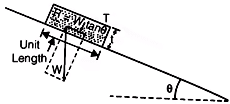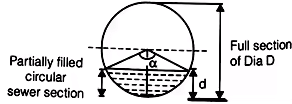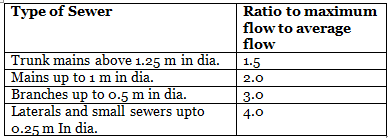Design of Sewer | Environmental Engineering - Civil Engineering (CE) PDF Download
Hydraulic formulas for Determining Flow Velocities in Sewers and Drains
(i) Chezy’s Formula
Where,
C = Chezy’s constant
S = Hydraulic gradient
R = Hydraulic mean depth or Hydraulic Radius

for circular sewer of dia D (in Running full)
Discharge,
Where,
A = Flow area of cross-section.
(a) Kutters Formula
Where,
n = Rugosity coefficient
S = Bed slope
(b) Bazin formula
Where, k = Bazin constant.
(ii) Manning’s Formula
(iii) Crimp and Burge’s Formula

This formula is close to Manning’s formula for all those sewer materials for which,
(iv) William Hazen’s Formula


Shields Expression for Self Cleansing Velocity

 where,
where,
f = Friction Factor
n = Porosity
sin θ ~ tan θ - Slope
⇒ θ = tan-1 (Slope)
G = Specific gravity of solid
d = Avg size of solid.
where, k = (1 - n) sin θ
Hydraulic Characteristics of Circular Sewer Free Board Provision
(i) Depth of partial flow

where,
α = Central angle in degree
d = Depth of partial flow
D Dia of full section
(ii) Proportionate depth, (d/D)
(iii) Proportionate depth, (a/A)
Where,

(iv) Proportionate perimeter
Where,
(v) Proportionate Hydraulic Mean Depth
(vi) Proportionate Velocity
(a) If
(vii) Proportionate Discharge
(viii) For two sewers whose degree of cleansing is same.

i.e.
(a) Ss/S = R/r
(b) Vs/V = N/n · (r/R)1/6
(c) qs/Q = N/n ·(a/A) (r/R)1/6
 design to run 1/2 full of Q design.
design to run 1/2 full of Q design. design to run 2/3 full of Q design.
design to run 2/3 full of Q design. design to run 3/4 full of design.
design to run 3/4 full of design.
where, ϕ Dia of sewer.
Qdesign = Design discharge.
Sewer is designed for Maximum Hourly Discharge
(i) Maximum hourly discharge
= 1.5 (Maximum daily discharge)
(ii) Maximum daily discharge
= 2.0 (Avg daily discharge)
(iii) Maximum hourly discharge
= 3.0 (Avg daily discharge)
Estimation of Peak Drainage Discharge
(i)
Where, k = Runoff/rainoff
Suffix 1,2, … n used for k is runoff of 1,2, ….n.
A = Area.
(ii)
(iii)

Where,
Maximum rainfall intensity of a particular frequency having duration equal to time of concentration.
po = (Point rainfall intensity of same frequency as PC) × Area dispersion factor. (cm/hr)
Tc = Time of concentration in hr.
(iv)

where,
QP = Peak discharge in m3/sec.
A = Catchment area in (Hectare)
Critical rainfall in (cm/hour)
|
14 videos|142 docs|98 tests
|
FAQs on Design of Sewer - Environmental Engineering - Civil Engineering (CE)
| 1. What is the purpose of sewer design in civil engineering? |  |
| 2. How is the sewer system designed in civil engineering? |  |
| 3. What are the different types of sewer systems used in civil engineering? |  |
| 4. What are the challenges in sewer design for civil engineers? |  |
| 5. How do civil engineers ensure the longevity of sewer systems? |  |
















